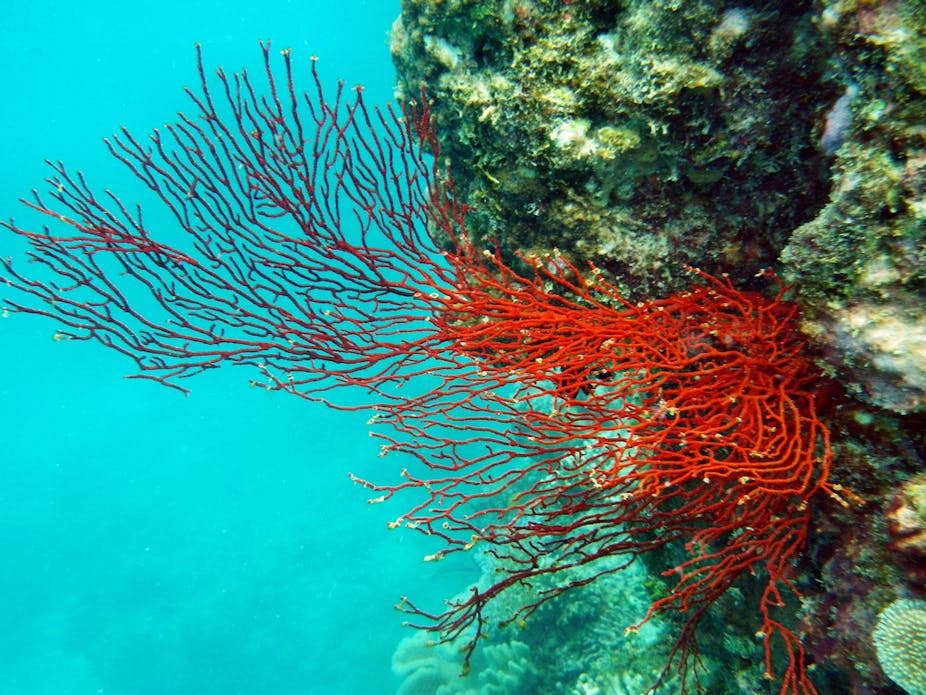One of the ambitions of the United Nations Framework Convention on Climate Change (UNFCCC) is galvanising the international community to avoid dangerous interference with Earth’s climate. To do this, it sets limits to the amount of change we can afford. But new research on reefs suggests the limits are too high.
The UNFCCC tries to reduce climate change to a point where humans have a chance to tolerate or adapt to any changes. The currently accepted point is 450 ppm of CO₂ in the atmosphere. But there is growing evidence that 450 ppm (which is likely to result in an average global temperature around 2 degrees warmer than the pre-industrial period) may result in unacceptable change and risks to natural and human systems.
In the case of the world’s ocean, 450 ppm will see us reach key thresholds such as under-saturation in the Southern Ocean. This is the concentration at which calcium carbonate crystals, in many shells and skeletons, no longer form naturally. This is also the point at which the resulting sea temperatures will begin to irreversibly impact ecosystems from coral reefs to kelp forests. These changes in the ocean are matched by similar points within terrestrial systems as the 450 ppm threshold is reached and exceeded.
Most importantly, 450 ppm appears to be the lowest emission scenario to deliver a climate that somewhat stabilises by the end of the century. At higher temperatures, the climate increasingly continues to change for many decades and centuries.
The “burning embers” diagrams from the Intergovernmental Panel on Climate Change in 2001 (see Figure 1) provide a convincing case for adopting a 450 ppm or 2°C climate change “guardrail” to avoid dangerous climate change. This sentiment was central to the synthesis report published by the Climate Change Congress held in Copenhagen in March 2009. Since then, it has become central plank of climate policy, driving discussions at the 15th Conference of the Parties (COP 15) and the United Nations Framework Convention on Climate Change later that year in Copenhagen.

But recent evidence suggests that the 450 ppm guardrail may not be as safe as at first thought. Our modelling study published in international journal Nature Climate Change this week reveals that increasing global temperatures to 2°C above pre-industrial global temperatures will be too hot for two-thirds of the world’s corals and reefs.
The study involved scientists from Potsdam, the University of British Columbia in Canada and the Universities of Melbourne and Queensland in Australia. To project the cumulative heat stress at 2160 reef locations worldwide, they used 19 global climate models that represent the combined work of the Coupled Model Intercomparison Project. By applying different emission scenarios covering the 21st century and multiple climate model simulations, a total of more than 32,000 simulation years was diagnosed. This allows for a more robust representation of the implications of the current set of climate projections, and consequently the inherent uncertainties, than any previous study.
The news from the study published today is not encouraging. Corals might be okay if they were able to adapt to the changes through rapid evolution. However, this is extremely optimistic and has little scientific evidence to support it.
Corals also have long generation times that may range from five to several hundred years, and often relatively low levels of genetic diversity. All of these features of their life cycle militate against the rapid evolution of corals to keep pace with rising sea temperatures.
In a nutshell, corals are not like fruit flies or bacteria, which have much shorter generation times (hours to weeks) and consequently can evolve relatively rapidly.

The paper also investigates what would happen if the susceptibility of corals to thermal stress increased as a result of other factors such as ocean acidification and pollution.
Ocean acidification is a consequence of the increasing amount of carbon dioxide entering the world oceans. Recent studies have indicated that the sensitivity of corals to thermal stress increases when they are exposed to acidified conditions. This situation has serious implications: current estimates of thermal sensitivity might underestimate, not overestimate, the future impact of climate change on corals.
On the basis of this information, the authors conclude that the thermal threshold required to protect at least half of the coral reefs worldwide lies at or below a 1.5°C mean increase in global average temperature.
The key question in all of this is how general the analysis and conclusions are for other systems. Recent observations of the behaviour of Arctic summer sea ice (which is plummeting and may disappear as early as the end of this decade) suggest that like corals, sea ice dynamics are much more sensitive to changes in greenhouse gases and hence average global temperature than at first thought.
We may have to revise our understanding of the vulnerability of Earth’s natural and physical systems. If so, we may need to rethink the past 2°C climate change guardrail and readjust it to 1.5°C or even lower. While this may seem like an ever-shifting guardrail, getting an accurate picture on where it lies is absolutely crucial to the international policy on climate change that the world is so desperately needs.

